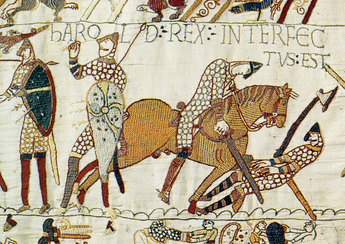
The death of King Harold at Hastings, as meted by the winning Normans in the Bayeux Wovenwork.
The Hild at Hastings was a fight between Earl William of Normany and King Harold II of England, on the sixteenth of October, in the Year of our Lord 1066. The Hild was fought over which of the two athelings had the right to the English kinghood after the death of King Edward Andettere, without children, at the beginning of that year. Earl William was akin to Edward through Edward's mother, Emma of Normany, but he was no offspring of the elder line of Angle-Saxish kings, and the Saxish lords upheld Earl Harold Godwinson's call for the kingship over the French outlander William.
Setting
William, calling out what he saw as backstabbing by Harold, was filled with wrath upon hearing tidings that Harold had been bewreathed as King. In the spring of 1066, he set about building a landraiding fleet, and in the fall, he went afaring for the shores of England with a landmight of skilled knights. These men, having given their lives over to warfare, were stronger on the field than Harold's mean fyrdmen.
No sooner had William set out, then Harold was met with another threat, this one from the north, by King Harald Hardrara of Norway, in band with Harold's backstabbing brother Tostig. Having slain both the Norwegian Harald and Tostig, and driven their men into the sea, King Harold fared about to the south.
Hild at Hastings
Upon coming to the stricken coast, Harold found that William had landed with many men but little goods or food. The wiser of Harold's rede-men pleaded with him to draw back his fyrdmen to London, saying that they were too tired from the earlier hild to again fight with their full might; moreover, William's strength could only dwindle as winter fell.
But Harold, in his pride, heeded them not, saying that he would guard his kingdom then and there, rather than let his coasts and towns be looted and burnt whilst he tarried out of sight of his harried folk. William offered to forestall a clash by putting the struggle to the Pope for his deeming, or else to end it by a one-on-one fight then and there. But Harold, being slighter of frame than William, did not believe that he could take him on himself, and trusted not the Pope, who had already foredoomed the thing for William and given the Norman his blessing and his fane.
Thus the landmights met in the Hild at Hastings on the sixteenth of October, and after six stounds of fighting, which was soothly most long for a clash in those days, Harold had fallen. If the winning Normans are to be believed, he met his end with an arrow through the eye. In the end the stronger and more skilled Norman knights and their swift horses had overcame the tired English fyrdmen.
Aftermath
After the Hild, William set his path for London, where the townsmen, knowing what had become of Harold, forsook their hastily-bewreathed King Edgar Atheling and gave the revetown up to William. William was glad upon seeing Westminster Abbey, the building of which had been the life's work of King Edward, who was truly sorrowful when his dying illness came ere he could see it fulldone and hallowed. William had himself bewreathed as King in this Abbey on Christmas Day, after which he built the Tower of London for a stronghold in the heart of his new rike, and also to show forth his might to the Englishmen, so that whatever hatred they felt towards him, they would not dare to stand against his rule.